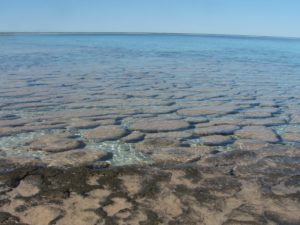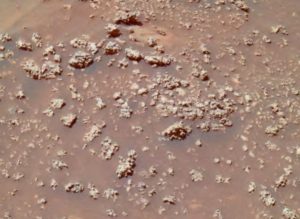Science Report #2 for October 7th
THE MARS ANALOGUE SIGNIFICANCE OF STROMATOLITES
Jonathan Clarke
Mars Society Australia
Stromatolites are laminated cone, column or dome-shaped structures formed by mineralised photosynthetic biofilms. The range in height from a few mm to several metres. Stromatolites are found in a wide range of subaqueous environments, including lakes, hot springs, tidal flats, lagoons, and saline springs. Perhaps the best known modern environment is Shark Bay, Australia.
Modern stromatolites in Shark Bay Australia
They are also among the oldest signs of life on Earth, recently reported from rocks that are 3.8 billion years old in Greenland. Furthermore, stromatolites often preserve microfossils, organic biomarkers, and isotopic signatures of biological activity and well known from the 3.5 billion year old rocks of the Pilbara region of Australia.
Stromatolites in 3.5 billion year old rocks of the Pilbara region of Australia
Early Mars was much more Earth-like than today, if life was ever present on the planet it is likely that stromatolites would be among the most easily recognised evidence for its presence. Possible related features, microbial mats in sandstones and geyserites (microbial deposits found in hot springs) have been tentatively been observed in imagery from the Spirit and Curiosity missions by Nora Nofke and Steve Ruff, respectively. These conclusions were made long after the rovers were driven away from the site and cannot be confirmed. Therefore timely recognition of stromatolites and the ability to revisit sites of interest is essential for any astrobiology mission to Mars to allow their detailed study. It is likely that only a crewed mission can enable this level of investigation and Mars-bound astronauts will have extensive training in their identification.
Possible geyserites observed by the Spirit rover mission in Gale Crater on Mars (NASA)
Stromatolitic Mars analogues enable us to determine how readily stromatolites can be recognised under Mars mission constraints and how best they can be studied in the field, what instrumentation should be used, and which samples should be returned for further study. The Mars 160 expedition will study two different stromatolite occurrences.
We aim to study three locations near the Mars Desert Research Station during the first phase of the Mars 160 mission. Already we have completed a scouting mission to the first of these. These stromatolite locations have been reported from three sites in the hinterland to the Mars Desert Research Station from the Navajo Formation, a succession of Jurassic (about 150 million years old) sand dunes. They occur in the depressions between the former dunes and are thought to have grown in pools fed by runoff or possibly groundwater. Some may be associated with spring vents, perhaps similar to the spring-fed stromatolites of Blue Lake in Australia. These are high value Mars analogues for conditions expected during Noachian and Early Hesperian Mars (prior to 3.5 billion years ago). During this epoch when ephemeral to semi-permanent lakes and pools in groundwater discharge are likely to have occurred in active dune fields are known to have been present, and runoff was high enough to support at least occasional river flow.
Documenting possible stromatolitic mounds in the Navajo Formation during the M160 expedition
During the second phase of the Mars 160 Expedition we will be able to study the diverse Silurian to Ordovician (roughly 450 to 500 million years ago) stromatolites of Devon Island. Unlike the rare and isolated stromatolites in the Navajo Formation, these form a major component part of large and extensive limestone formations deposited in a warm shallow ocean, not unlike the modern Persian Gulf.







